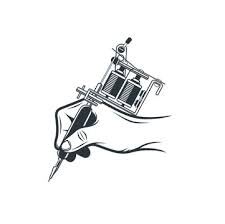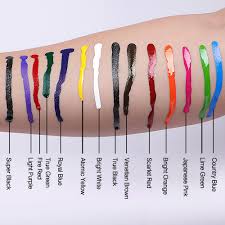Tattoo cover-ups are a popular solution for individuals who wish to modify or completely change their existing tattoos.
One common challenge in this process is determining the best color ink to effectively cover a red tattoo.
The vibrant and bold nature of red ink can make it difficult to conceal with lighter or equally bright colors.
Understanding the right color choices and techniques is crucial for a successful cover-up that meets your aesthetic goals.
In this guide, we will go into the specifics of covering a red tattoo, exploring the science of color theory, the most suitable ink colors for cover-ups, and essential tips for a seamless transformation.
Whether you’re a tattoo enthusiast considering a change or a professional tattoo artist seeking deeper insights, this comprehensive guide will provide valuable information to achieve the best results.
Understanding Color Theory
Color theory plays a pivotal role in tattoo cover-ups. At its core, color theory is the study of how colors interact with each other.
This understanding is crucial when trying to cover one color with another.
The color wheel, a fundamental tool in color theory, helps us visualize these interactions.
Colors opposite each other on the color wheel are called complementary colors and can effectively neutralize each other.
Red, positioned opposite green on the color wheel, can be neutralized or balanced with green hues.
This principle is vital when considering which ink color to use for covering a red tattoo.
However, the final choice also depends on the design and desired outcome of the new tattoo.
Best Ink Colors for Covering a Red Tattoo
Green
Green is a natural choice for covering red tattoos due to its position opposite red on the color wheel.
Dark green shades, in particular, are effective because they provide enough contrast to mask the red underneath.
Lighter greens might not offer the same level of coverage and could result in a blended or muddy appearance.
Blue
Blue is another strong contender for covering red tattoos.
While it’s not directly opposite red on the color wheel, blue’s deep, cool tones can overshadow the warm, vibrant nature of red.
Navy blue and other dark shades of blue are particularly effective in providing thorough coverage.
Black
Black is often considered the ultimate cover-up color for any tattoo, including red ones.
Its depth and opacity make it highly effective in concealing previous ink. Black can completely mask the red, ensuring that no hints of the original tattoo are visible.
However, using black limits the color palette for the new design.
Purple
Purple, a blend of red and blue, can also be used to cover a red tattoo, especially if you prefer a more colorful solution.
Dark purple tones can effectively obscure the red while adding a unique and vibrant touch to the new design.
However, the success of this color depends on the specific shades involved.
Techniques for Effective Tattoo Cover-Ups
Layering
Layering involves applying multiple layers of ink over the existing tattoo to build up opacity and coverage.
This technique is particularly useful when dealing with vibrant colors like red. Each layer adds depth and helps to obscure the original ink, resulting in a more seamless cover-up.
Shading
Shading uses gradients of color to blend the new tattoo with the old one.
This technique can be effective in softening the harsh lines and bold colors of the original tattoo, making it less noticeable. By incorporating shades of the chosen cover-up color, artists can create a smoother transition.
Detailing
Adding intricate details to the new design can help distract from the underlying red tattoo.
Fine lines, patterns, and highlights draw attention away from the covered area, making the old tattoo less discernible.
This technique is especially useful when the cover-up involves complex designs.
Factors to Consider Before Covering a Red Tattoo
Skin Tone
Your skin tone plays a significant role in how the cover-up will look. Different colors interact differently with various skin tones. For instance, darker skin tones might require richer, more intense colors for effective coverage, while lighter skin tones might allow for more flexibility with color choices.
Tattoo Size and Placement
The size and placement of the original tattoo can impact the cover-up process. Larger tattoos might require more extensive designs to cover effectively, while smaller tattoos might be easier to conceal with simple patterns or shapes. Additionally, the location on the body can affect how well certain colors take to the skin.
Condition of the Existing Tattoo
The age and condition of the original tattoo are crucial factors. Older tattoos that have faded might be easier to cover than fresh, vibrant ones. Additionally, tattoos with smooth, even lines are typically simpler to conceal than those with blurred or uneven edges.
Preparing for a Tattoo Cover-Up
Consultation with a Professional
A successful tattoo cover-up starts with a thorough consultation with a professional tattoo artist. An experienced artist can assess the existing tattoo, discuss your goals, and recommend the best approach for covering the red ink. They can also provide insights into what designs and colors will work best for your skin tone and the specific characteristics of your original tattoo.
Design Planning
Careful planning of the new design is essential for a successful cover-up. This involves selecting a design that not only meets your aesthetic preferences but also effectively conceals the red tattoo. Consider incorporating elements that naturally blend with the original tattoo, such as similar shapes or patterns.
Skin Preparation
Proper skin preparation is crucial for optimal ink absorption and healing. Ensure the area is clean and free from any irritants. Hydrated skin tends to take ink better, so moisturizing in the weeks leading up to the cover-up session can be beneficial. Avoid sun exposure and other activities that might irritate the skin.
Aftercare for Tattoo Cover-Ups
Immediate Care
After the cover-up session, follow the artist’s aftercare instructions meticulously. This usually involves keeping the area clean, applying recommended ointments, and avoiding direct sunlight or soaking the tattoo in water. Proper care ensures the new ink settles well and reduces the risk of complications.
Long-Term Care
Long-term care is essential to maintain the vibrancy and integrity of the cover-up tattoo. This includes regular moisturizing, protecting the tattoo from excessive sun exposure, and avoiding abrasive skin treatments. Periodic touch-ups might be necessary to keep the cover-up looking fresh and ensure the red ink remains hidden.
Conclusion
Covering a red tattoo requires a thoughtful approach, combining an understanding of color theory, careful design planning, and expert tattooing techniques.
Green, blue, black, and purple are among the best colors for effectively concealing red ink.
Each color choice offers unique benefits, and the final decision should be made in consultation with a professional tattoo artist.
By considering factors such as skin tone, tattoo size, and the condition of the existing tattoo, you can achieve a successful and aesthetically pleasing cover-up.
Proper preparation and aftercare further enhance the results, ensuring your new tattoo looks vibrant and lasts for years to come.

I’m Tommy Hanks, a professional tattoo artist with over a decade of experience under my belt.
I’ve always had a passion for art, and tattooing has become my favorite medium for expressing creativity.
I own and operate a successful tattoo studio, where I get to create intricate designs and connect with a diverse range of clients.
In addition to my work in the studio, I run a blog called taggrs.com.
Through my blog, I share my experiences, insights into the latest tattoo trends, and tips for both aspiring tattoo artists and enthusiasts.
Tattooing is more than just a job for me; it’s a lifelong journey, and I love being able to share that journey with others.

